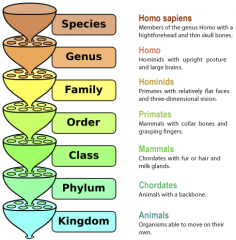![]()
![]()
![]()
Use LEFT and RIGHT arrow keys to navigate between flashcards;
Use UP and DOWN arrow keys to flip the card;
H to show hint;
A reads text to speech;
33 Cards in this Set
- Front
- Back
|
The process in which the mitochondria, in cells of plants, animals and other multicellular organisms break down carbs and other energy-rich products derived from them, such as fats, to generate molecules of ATP (energy made in the mitochondria). |
Cellular Respiration |
|
|
The process by which plants, algae, and some kinds of bacteria use the Sun's light energy to chemically convert carbon (inorganic) into carbs (organic) such as sugars and starches. |
Photosynthesis |
|
|
Organisms that synthesizes its own food from inorganic molecules by using light or chemical energy; also known as autotroph. |
Producers |
|
|
An organism that cannot synthesize its own food through photosynthesis or chemosynthesis, and must derive some of its nutrients from organic molecules formed by producers (autotroph) also known as heterotrophy |
Consumers |
|
|
Albedo |
Percentage of incoming solar radiation reflected by a surface |
|
|
The process by which certain fungi and bacteria use the energy from chemical nutrients to chemically convert carbon (inorganic) into carbohydrates (organic) such as sugars and starches in the absence of light.
|
Chemosynthesis
|
|
|
Organism that obtains energy by eating plants; also known as a herbivore.
|
Primary consumers
|
|
|
Organism that eats primary consumers
|
Secondary consumers
|
|
|
Organism that eats secondary consumers
|
Tertiary consumers
|
|
|
Organism, usually bacterium, fungus, earthworm, or insect, that obtains energy by consuming dead plant and animal matter or waste.
|
Decomposers
|
|
|
In an ecosystem, a feeding level through which energy and matter are transferred; indicates an organism's position in the food chain and it's determined by the number of energy transfer steps required to reach each level.
|
Trophic level
|
|
|
Model showing the linear pathways through which food (energy) Is transferred from producers to primary consumers and to higher trophic levels.
|
Food chain
|
|
|
model of food (energy) transfer in an ecosystem that shows the connections among food chains
|
Food web
|
|
|
Food web
|
Pyramid of numbers
|
|
|
total dry mass of all the living, or once-living, organisms in a given population, area, or other unit being measured.
|
Biomass
|
|
|
schematic representation of the relative amount of biomass at each trophic level.
|
Pyramid of biomass
|
|
|
schematic representation of the relative amount of energy at each trophic level.
|
Pyramid of energy
|
|
|
A law that states that energy can not be created or destroyed, it can only change from one form to another. |
First law of thermodynamics |
|
|
The law states that during any energy conversion, some enery is convered into unusable forms - mostly heat (thermal energy), also known as waste energy |
Second law of thermodynamics |
|
|
The Linnaean Classification of Living things |

|
|
|
The most accurate way to show energy loss in an ecosystem is to obtain a relative sampling of biomass from each trophic level and burn it in a calorimeter to discover the exact amount of energy contained in these living organisms. By subtracting the energy contained in a trophic level from the energy contained in the trophic level below itself, you can discover the exact amount of energy lost from one level to the next higher level. An energy loss pyramid accurately shows energy loss as you go up trophic levels. |
Energy Transfer |
|
|
True or False: Earth is a closed system in terms of matter & an open system in terms of energy. |
True |
|
|
True or false: Carbon sinks include Earth's forests & oceans. |
True |
|
|
Lightening discharges during storms are able to combine nitrogen gas (N2) with oxygen gas (O2) in a chemical reaction that forms nitrate ions (NO3-). What is this an example of? |
Nitrogen Fixation |
|
|
This type of bacteria lives in little nodules on the roots of certain types of plants, such as alfalfa and clover. They have the ability to convert nitrogen from the air (there is air between soil particles) to nitrates for the plant that it lives on and extra for the soil for other plants to use as a nutrient. What type of bacteria is this? |
Nitrogen-Fixing Bacteria |
|
|
Decomposing bacteria exist in the soil and break down the waste from animals and plants and the actual bodies of these living things when they ultimately die. These bacteria break down the proteins that make up their bodies converting these molecules to nitrates (NO3) then nitrites (NO2) which can then be used as nutrients (a component of fertilizers) for plants to grow, which in turn are eaten by animals for their growth. Nitrites (NO2) are unstable, and if not used by the plants, will eventually react with the air to form nitrogen gas again. Thus, the nitrogen repeats. What bacteria is this |
Denitrifying Bacteria |
|
|
C6H12O6+6O2→6CO2+6H2O+energy What is this chemical formula for? |
Cellular Respiration |
|
|
what percentage of water do you have in your body ? |
70% |
|
|
Order of tropic levels are? |
1. Producers 2. Primary Consumers 2. Secondary Consumers 3. Tertiary Consumers |
|
|
How much percent of energy gets past each tropic level? |
10% |
|
|
is a universal solvent high melting point and boiling point Polar high specific heat capacity what substance is it ? |
Water, H20 |
|
|
what is ABIOTIC mean? |
non living |
|
|
what does biotic mean ? |
living |

